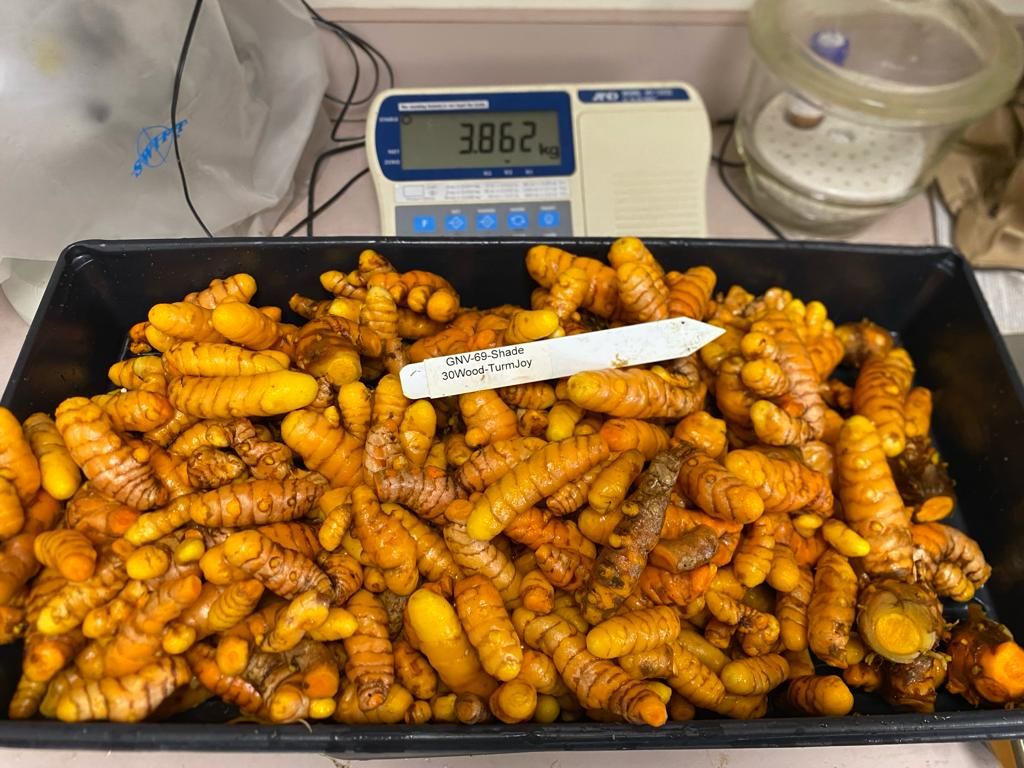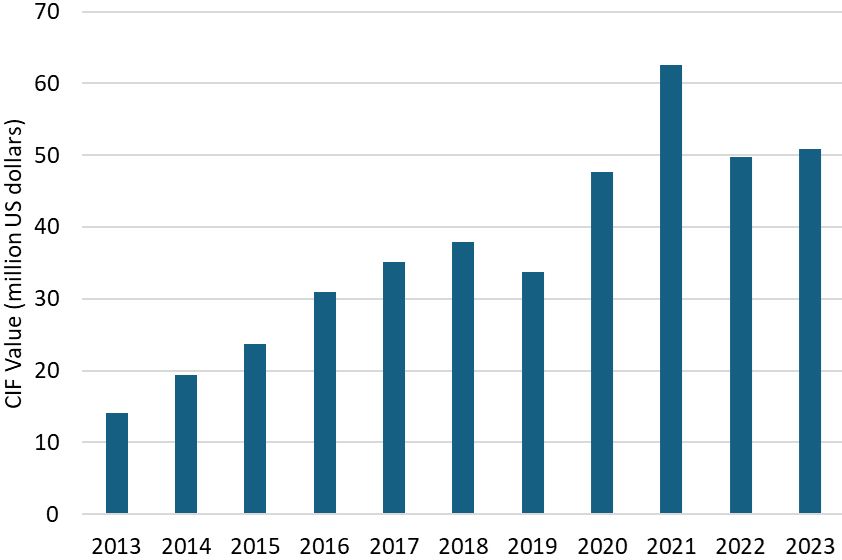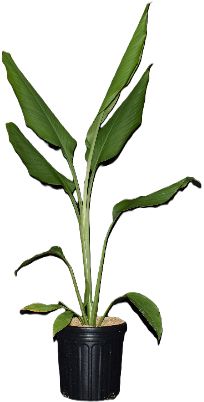Introduction
Turmeric (Curcuma longa and related species) is a genus in the ginger family. Turmeric rhizomes are commonly used in Asian cuisine, often as a powdered spice. Curcumin, a polyphenol found in turmeric, provides numerous health benefits due to its antioxidant and anti-inflammatory properties (Hewlings and Kalman 2017).
This publication summarizes research on potential markets for Florida-grown turmeric, including fresh produce markets, food and beverage ingredient markets, and nursery markets. The purpose of the publication is to provide information that will assist prospective turmeric producers with their marketing plans.
A marketing plan typically covers "the four Ps": (1) product forms and attributes, (2) places where the product will be sold, (3) price points, and (4) promotion (Evans and Ballen 2015). This publication does not provide a marketing plan, which should be tailored to each producer’s unique situation, but it does provide information on potential markets that a producer could consider in developing the four Ps of a marketing plan.
This research was funded by the UF/IFAS Support for Emerging Enterprise Development Integration Teams (SEEDIT) program and a US Department of Agriculture Specialty Crop Block Grant administered through the Florida Department of Agriculture and Consumer Services (FDACS). The project included research on Florida production and markets for ginger, galangal, and turmeric. We compiled and analyzed import and terminal market data and conducted semi-structured interviews with market participants. Interview participants included seven food or beverage manufacturers, three tea shops, three fresh produce marketers, three retail nurseries, a plant liner supplier, and a marketing consultant.
Fresh Produce Markets
Florida turmeric growers have opportunities to sell turmeric in its fresh, whole form. Prospective turmeric growers must select the type of turmeric they will sell and consider the types of buyers and market channels available. Small growers have opportunities to sell fresh produce (Figure 1) directly to final consumers at retail prices (such as at farmers’ markets, farmstands, and online). Selling directly to retailers and restaurants at wholesale prices could be another option for small turmeric growers.

Credit: Raúl Cabezón, UF/IFAS
Most turmeric consumed in the United States is imported. Produce importers and distributors sell turmeric to retailers, wholesalers, food service, and food or beverage manufacturers. In some cases, the importers are integrated global companies that grow, pack, and distribute turmeric. Prospective turmeric growers must consider whether they can compete with imported turmeric at similar price points or differentiate their turmeric to obtain a higher price. Information on import values, prices at Florida ports of entry, and wholesale prices are provided below.
The annual Cost, Insurance, and Freight (CIF) value of turmeric imports to the US rose from $14 million in 2013 to $51 million in 2023 (US Census Bureau 2024). This trend indicates strong growth in US sales of turmeric. In 2021, turmeric imports spiked to $63 million (Figure 2), possibly an outlier related to the COVID-19 pandemic. The CIF value includes the cost of the goods plus insurance and freight costs to deliver to a US port but excludes import duties paid. At the time of writing, no import duty (tariff) is assessed on imported turmeric (US-ITC 2024).

Credit: US Census Bureau 2024
Turmeric imports to the United States came from 48 different countries over the past five years (US Census Bureau 2024). The top four origins by average annual CIF value between 2019 and 2023 were India ($31 million), Fiji ($10 million), China ($2 million), and Jamaica ($1 million).
Turmeric is sold wholesale in 10 lb and 30 lb cartons and 30 lb and 40 lb mesh sacks. In 2021 through 2023, US East Coast terminal markets reporting turmeric sales included Baltimore, Boston, Chicago, Detroit, Miami, New York, and Philadelphia. Most turmeric sold at these terminal markets is from Jamaica or Fiji Islands. Other origins reported in 2021 to 2023 included Hawaii, Florida, Mexico, Thailand, and Dominican Republic. Wholesale turmeric prices show significant variation, but no consistent seasonal pattern is evident (USDA-AMS 2024).
Terminal market price reports indicate turmeric variety as either orange-type, white-type, or unspecified. Orange-type varieties are much more common. Between 2021 and 2023, white-type only appeared in 2021 at the Chicago terminal market and was priced nearly the same as orange-type (USDA-AMS 2024). Although these wholesale reports only identify orange-type and white-type, turmeric is available in several different color types (Figure 3).

Credit: Sofia Flores, UF/IFAS
Table 1 shows unweighted annual averages of daily low and high prices for orange-type turmeric, not labeled organic, from selected origins, and sold in 30 lb cartons or mesh sacks at US East Coast terminal markets. Turmeric from Fiji typically sold at higher prices than turmeric from Jamaica. Florida turmeric was reported at the Chicago terminal market in 2021 and sold at a premium relative to Hawaiian, Fijian, and Jamaican turmeric. Overall, prices followed a declining trend with the 2021 average price at $3.16 per pound and the 2023 average price at $2.95 per pound (USDA-AMS 2024).
Table 1. Unweighted annual averages of daily low and high prices ($/lb) for orange-type turmeric in 30 lb cartons or mesh sacks (not labeled organic), from selected origins, and sold at US East Coast terminal markets. Data source: USDA-AMS 2024.
Orange-type turmeric appears occasionally with an organic label, usually at a price that is higher than turmeric without the organic label. Table 2 shows a comparison of prices for organic and nonorganic turmeric at terminal markets where both were sold in a given year. The prices shown are for orange-type turmeric sold in 30 lb cartons or mesh sacks. The organic price premium ranges from 2% to 56% in these cases (USDA-AMS 2024).
Table 2. Unweighted annual averages of daily low and high prices ($/lb) for orange-type turmeric in 30 lb cartons or mesh sacks, organic vs. nonorganic, and sold at US East Coast terminal markets. Data source: USDA-AMS 2024.
Smaller container sizes sell at a higher price per pound. Table 3 shows unweighted annual average prices for three different pack sizes. Average prices in 2023 ranged from $3.12 per pound for turmeric in 10 lb cartons to $1.83 per pound for turmeric in 40 lb mesh sacks (USDA-AMS 2024).
Table 3. Unweighted annual averages of daily low and high prices for orange-type turmeric, not labeled organic, and sold at US East Coast terminal markets by package size. Data source: USDA-AMS 2024.
Retail prices for turmeric are not available from USDA, but we observed turmeric selling at supermarkets, farmers’ markets, and online. Turmeric at a north Florida supermarket was priced at $5.99 in a 6 oz clamshell ($15.97/lb), and prices observed at north Florida farmers’ markets were $4.00/pint and $2.50/oz ($40/lb). Websites were observed selling fresh, whole turmeric in 2022 at prices ranging from $10.00/lb to $24.00/lb for package sizes of 2 pounds or less, mostly organic. Fresh black turmeric was observed selling online for up to $49/lb. Direct marketing of unique varieties to final consumers provides opportunities for local growers to obtain retail prices that are much higher than average wholesale prices.
Food Supplement and Ingredient Markets
Turmeric is often sold as a spice in ground or powdered form. Many dietary supplements are available with turmeric curcumin as a primary ingredient. Potential buyers of turmeric include craft breweries, tea blenders, and natural food and nutritional supplement manufacturers. Some food and beverage manufacturers will purchase fresh turmeric and process it into final consumer products. Many food and beverage manufacturers, however, prefer to purchase turmeric already in a processed form, such as dried powder or oleoresin (semi-solid extract). Some companies specialize in preparing processed ingredients to sell to manufacturers of final consumer products.
We interviewed two natural ingredient and supplement manufacturers, two tea or juice manufacturers, and two craft breweries, all of whom purchase turmeric. The manufacturers we interviewed purchase turmeric as oleoresin, a concentrated extract derived from dried biomass; or as dried slices or powdered. The turmeric they purchase comes from India, Sri Lanka, or Indonesia, and one manufacturer mentioned sourcing processed turmeric from Germany. Craft breweries are most interested in purchasing turmeric as unconcentrated juice, concentrated extract, puree, powder, or essential oil. They prefer not to purchase turmeric in fresh form.
The price of processed turmeric depends on the curcumin content; higher curcumin contents are associated with higher prices. Other turmeric attributes that manufacturers said can affect price include organic, fair trade, and color. Clean products and food safety standards are also important to food and beverage manufacturers purchasing turmeric. All the manufacturers we interviewed believed that Florida-grown turmeric could sell at a premium, but the amount of premium depends on the market and customer segment.
Nursery Markets
Nursery growers have opportunities to sell turmeric seed rhizomes or potted plants to turmeric farmers, homeowners, retail nurseries, or garden stores (Figure 4). Container turmeric could have market appeal to home gardening enthusiasts similar to other crops grown in containers (e.g., tomatoes, herbs, etc.) or to producers with limited space or land (i.e., urban farmers). Nursery industry statistics and takeaways from interviews with three Florida nurseries are described later in this section.

Credit: Carly Nelson, UF/IFAS
The value of horticultural specialty crops (plants, flowers, seedlings, bulbs) sold in 2019 was $13.8 billion in the United States and $1.9 billion in Florida. The plants sold in these markets were grown by 20,665 producers in the United States and 1,689 producers in Florida. Bedding/garden plants accounted for 23%, nursery stock for 33%, and dried bulbs, corms, rhizomes, and tubers for less than 1% of the industry value nationwide (USDA-NASS 2019). Turmeric might be sold in any of those three horticultural categories.
We interviewed three retail nurseries located in Florida that currently sell or previously sold turmeric plants. The nursery that sold turmeric in the past said it did not sell that well, but the other two indicated strong demand for turmeric among their clientele. The nurseries said that wholesale supply of turmeric plants is very inconsistent.
The size of containers purchased and sold by nurseries varies. Among the three nurseries we interviewed, one usually buys and resells vegetables and herbs in 4-inch and 6-inch containers. Another said that it typically buys and resells turmeric in 8-inch or 1.5-gallon pots. A third nursery mostly purchases turmeric in 72-count trays, then grows out for sale in 4-inch and 6-inch pots.
Retail prices for containerized turmeric plants that were observed and mentioned in interviews in 2021 ranged from $12 to $20. Container sizes at those price points ranged from 4-inch pots to 3-gallon pots.
Nursery retailers mentioned seasonal cycles. One said that 60% of business occurs from March 1st to June 1st. Dormancy cycles of turmeric are also a factor. It is difficult to sell turmeric plants in late fall and winter when leaves turn yellow and die back.
Although demand for edible plants sold by nurseries has grown in recent years, it is still a relatively small portion of total nursery sales. Most nursery sales are in the ornamental category. One nursery said that edibles are 5% of sales, and another said edibles are 10%–20% of sales. Because turmeric is a small niche in nursery markets, turmeric plant or seed rhizome sellers should plan production quantities and timing based on sales estimates for specific buyers or markets.
Conclusions
Florida turmeric producers have opportunities to sell turmeric as fresh produce; as a food, beverage, or supplement ingredient; and as a nursery plant. Turmeric producers will have to find efficiencies in production, harvesting, and postharvest handling, and must develop effective marketing strategies to be successful.
Wholesale prices for fresh turmeric typically range from about $2.00 per pound to about $4.00 per pound. The majority of turmeric sold at wholesale terminal markets is imported. Sales of Florida turmeric at the Chicago terminal market in 2021 showed a price premium relative to turmeric from other origins, selling for an average wholesale price of $3.93 per pound. Turmeric labeled as organic typically sells for a higher wholesale price than turmeric without the organic label. The wholesale price data show that higher prices can be obtained for turmeric differentiated based on origin or quality characteristics.
Retail prices for fresh turmeric are substantially higher than wholesale prices. Large variations were observed in retail prices for fresh turmeric, demonstrating that differences in origin, market outlet, and turmeric variety can have a substantial effect on price, as can various other quality characteristics.
Florida turmeric producers could supply food, beverage, or supplement manufacturing companies. However, final manufacturers often prefer to purchase turmeric in processed form (dried/ground, liquid extract, oleoresin, or oil). Processing facilities are needed to expand opportunities for selling local turmeric to food and beverage manufacturers.
Selling turmeric as seed rhizomes or container plants is another option. Retail nurseries reported having difficulty obtaining a consistent supply of turmeric plants from nursery wholesalers, indicating an opportunity to expand the production of turmeric plants to supply retail nurseries in Florida. Import competition is less of a factor for nursery plants than it is for fresh turmeric or turmeric processed for food and beverage ingredients.
Recent consumer trends showing increasing interest in healthy (nutraceutical and functional) foods, ethnic cooking, and locally sourced food provide market opportunities for turmeric. Much of the growth in US sales of turmeric has come from imports, but Florida producers may be able to capture a share of this growing market. Research on different varieties (e.g., orange, white, black, and blue turmeric); organic production methods; extending the harvest season; and postharvest handling and processing techniques could potentially help the marketability of Florida-grown turmeric.
References
Evans, E. A., and F. H. Ballen. 2015. “Eight Steps to Developing a Simple Marketing Plan: FE967 FE967, 8 2015.” EDIS 2015 (6). Gainesville, FL:5. https://doi.org/10.32473/edis-fe967-2015
Hewlings, S. J., and D. S. Kalman. 2017. “Curcumin: A Review of Its Effects on Human Health.” Foods 6 (10): 92. https://doi.org/10.3390/foods6100092
US Census Bureau, Economic Indicators Division, USA Trade Online. 2024. U.S. import and export merchandise trade statistics. Accessed July 5, 2024. https://usatrade.census.gov/
US Department of Agriculture, Agricultural Marketing Service (USDA-AMS). 2024. Run a custom report. Accessed July 6, 2024. https://www.ams.usda.gov/market-news/custom-reports
US Department of Agriculture, National Agricultural Statistics Service (USDA-NASS). 2024. 2019 Census of Horticultural Specialties. https://www.nass.usda.gov/Publications/AgCensus/2017/Online_Resources/Census_of_Horticulture_Specialties/index.php
US International Trade Commission (US-ITC). 2024. Harmonized Tariff Schedule of the United States (2024) Revision 4. Accessed July 6, 2024. https://hts.usitc.gov/